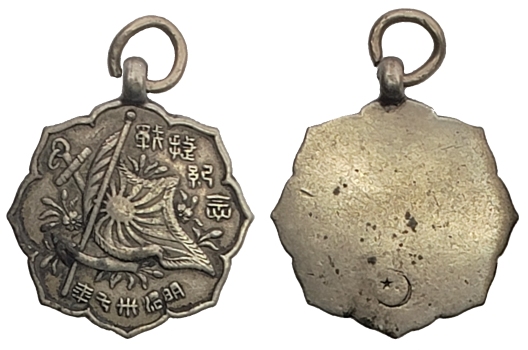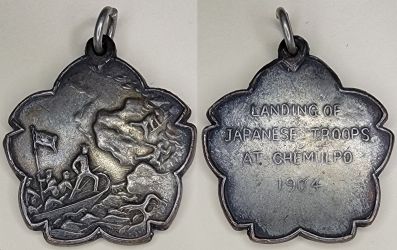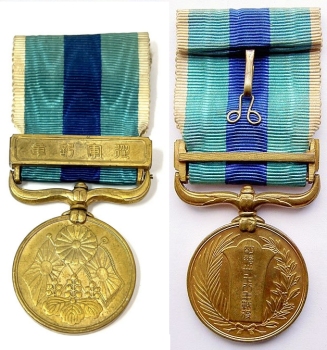The Russo-Japanese War (露日戦争) was fought over rival ambitions for dominance in both Manchuria and the Korean Empire. The major theaters of operations were located in the Liaodong Peninsula 遼東半島, Mukden (modern Shenyang 瀋陽) and in the seas around Korea and Japan.
Russia needed an ice-free port for both for its imperial navy and for maritime trade. The primary Russian port on the Pacific Ocean was Vladivostok, but it was only fully operational during the summer. In 1898, Port Arthur, which was an ice-free port on the Liaodong peninsula, was leased to Russia by the Chinese. Also in 1898, Russia acquired mining and forest concessions near the Yalu and Tumen Rivers. Japan was concerned that this Russian encroachment would interfere with their plans to establish a dominant sphere of influence in Korea. Japan did offer to recognize Russian dominance in Manchuria in exchange for their recognition of Japanese dominance in Korea. Russia, in turn, demanded the establishment of a neutral buffer zone between them. The Imperial Japanese Government perceived this as obstructionist and chose to go to war. Once negotiations had broken off, the Imperial Japanese Navy opened hostilities with a surprise attack on the Russian Eastern Fleet at Port Arthur on Feb. 9, 1904. There were a number of key factors that came into play for the decision to attack. The Russian Trans-Siberian Railway was under construction and Japan wanted to attack before its completion, otherwise, Russia could easily resupply its forces in the Far East. Japan had also concluded the first Anglo-Japanese Alliance (日英同盟) in January 1902. Because of this Alliance, other nations could not assist Russia without bringing England into the conflict on the Japanese side, and thus leading to an even wider conflict. 1

The top inscription is 戰捷記念 (전첩기념) Victory Medal
The bottom inscription is 明治丗七年 (명치세七년) Meiji 37th Year (1904).
There is a “Moon and Star” hallmark on the reverse. This has been seen on other medals, but to date, no one has determined who the manufacturer was.

The Battle of Chemulpo Bay occurred on Feb. 8 & 9, 1904
The opening stage of the Russo-Japanese War began with preemptive strikes by the Imperial Japanese Navy. The Russian Pacific Fleet was attacked at Chemulpo Bay (Inchon, Korea) and Port Arthur on the Liaoning Peninsula (China).
In Korea, on Feb. 8, 1904, the Japanese disembarked four battalions of soldiers of the Imperial Japanese Army’s 12th Division at Chemulpo (Inchon) within sight of the Russian ships at anchor. Although outgunned and outnumbered, the Russian ships Varyag and Korietz attempted to make a break for the open sea, but failed. The ships returned to Chemulpo and were scuttled by their crews. The cruiser Varyag was later re-floated and became the Japanese training ship Soya.
The Russian Pacific fleet from Vladivostok, recognizing that it was no match for the Japanese navy, took shelter in the heavily fortified harbor of Port Arthur. Japan initiated a surprise attack, but was not able to destroy the Russian fleet. So the Japanese navy blockaded the harbor, while the army, with horrendous losses, fought and took Hill 203 in Dec. of 1904. From this new position, with its height, Japan was able to destroy the entire Russian Fleet in Port Arthur.
In the meantime, the Russian Baltic Fleet was dispatched to assist the Pacific Fleet. The Baltic Fleet left the port of Liepaja in present day Latvia in October 1904. During the trip, the fleet needed to be resupplied with coal and made a number of port calls. With each port call, the Japanese population could easily follow the Russian navies gradual approach towards Japan. There was great anticipation about the upcoming naval battle, so at the end of May 1905, when Togo’s fleet intercepted and destroyed the Baltic fleet, Japan exploded in jubilation. It was an unbelievable victory for Japan, as no one believed that they could win against Russia. 2
The Japanese war effort needed funding, and their war bonds were not selling overseas. No one felt that the Japanese could defeat the Russian Empire. If it had not been for Jacob Henry Schiff (1847 – 1920), a German-born Jewish American banker, businessman, and philanthropist, Japan would have fallen into total bankruptcy.3
The Treaty of Portsmouth was concluded on September 5, 1905, with the help of U.S. President Teddy Roosevelt. For his participation, the president received the Nobel Peace Prize in 1906.4
The Russo-Japanese War Medal5

Three months after signing the Peace Treaty, a new design for a Russo-Japanese War Medal was on the Prime Minister’s desk. The Army had commissioned the prestigious Tokyo School of Arts 東京美術学校. The army received a design proposal on December 7, 1905. The final design of the 1904-05 medal was a revised version of this proposal. On February 3, 1906, the Decorations Bureau offered a Counterproposal. Between the two proposals, the cabinet approved a compromised design on March 7, 1906, which was signed by Emperor Meiji as Edict 51 on March 30, 1906. On April 7, 1906, the Prime Minister released Cabinet Ordinance #2 which designated April 1, 1906, as the award date for all Russo-Japanese War Medal documents. Actual awarding of the Russo-Japanese War medals did not commence until the middle of December 1906.
The Japanese had developed a tradition of referring to armed conflicts by years of engagement only, without mentioning the country they had fought against. Because of this, the obverse bar has the inscription 従軍記章 (종군기장) “War Medal”. At the top of the planchet is the Chrysanthemum representing the Emperor, there are Paulownia leaves and flowers at the bottom representing the Japanese Government, and two crossed flags represent the Army and Navy.
The reverse has a crossed sprig of laurel 名誉樹葉 and palm frond 戦勝樹葉 with a shield in the center. The reverse inscription is 明治十十十七八年戦役 “Meiji 38-9 Year War Medal. 6
The ribbon is white, green and blue. It is possible that, the ribbon colors symbolize the Army (green) and Navy (blue).
Footnotes:
- The alliance was renewed and expanded in scope twice, in 1905 and 1911, before its demise in 1921 and termination in 1923.
- At his victory celebration, Admiral Togo Heihachiro stated: “You may compare me with Lord Nelson, but not with Yi Sun-sin. Next to him, I am only a petty officer”. Korea’s Admiral Yi Sun-sin never lost a naval engagement during the Japanese invasion of Korea in 1592-98 and today, the 3rd Class of Korea’s Order of Military Merit is named after him.
- It is claimed, that Jacob Henry Schiff made the $200 million loan, as an act of defiance for the Russian pogroms against their Jewish population.
- A very controversial award, considering America had colonial ambitions of its own.
- For a far more extensive treatment of this medal see: www.warrelics.eu/forum
- The use of 十十十 as a single ideogram is an older style of writing “30” and is not the way it is handled today, which is 三十.
